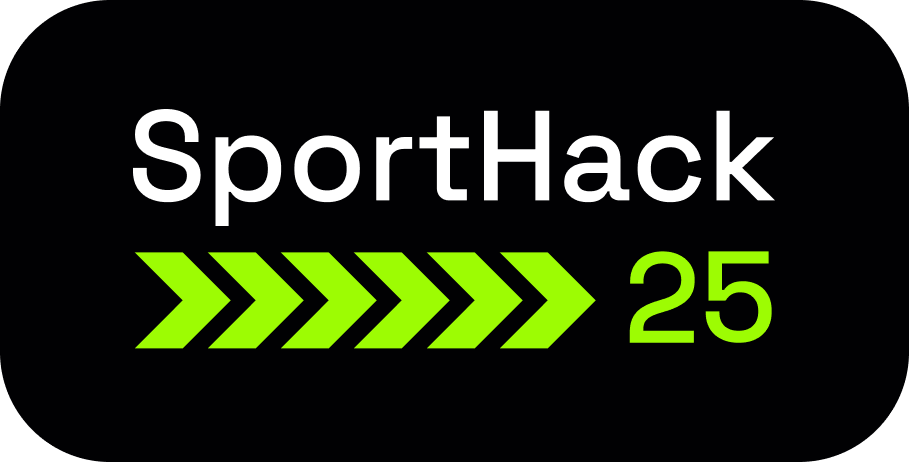Innovation hackathon
11/11 - 15/11 Online & Onsite
Innovation hackathon





This theme focuses on leveraging data and AI for smarter performance, safer training, and better decisions. Participants are encouraged to develop solutions that analyze performance data, prevent injuries, or enhance strategic decision-making in sports.
This theme is about turning fans into active participants. Participants are challenged to create immersive solutions using XR, gamification, and interactive platforms to deepen fan engagement and create new ways to experience sports.
This theme centers on designing a greener, more diverse, and inclusive future for sports. Projects could focus on reducing the environmental impact of sporting events, promoting accessibility, or fostering diversity within sports communities.
This theme features challenges from our partners, complete with real data, tools, and expert support. Participants can tackle real-world problems defined by industry leaders, with solutions ranging from apps and AI platforms to wearable devices or sensor-powered drones.
- New Ideas, New TeamsIf you’re a group of thinkers and dreamers with a concept that could revolutionize the sports world, SportHack 2025 is for you. While some preparatory work, such as market analysis and brainstorming, is encouraged, the key requirement is that the idea should not yet have materialized into a developed solution. Individuals with bold ideas are also welcome to join, but participation requires forming or joining a team through pre-event networking before the hackathon begins.
- Early Stage Start-upsYour team is welcome if you’ve moved beyond the ideation stage and have started shaping your innovative solution. The key criterion is that your solution should not yet be commercially available or have received funding from investors. SportHack 2025 is perfect for early-stage startups that are still refining their product or service — an opportunity to test, validate, and enhance your sports innovation in a supportive environment.
- Business PeopleMarket trends, operations, and domain know-how.
- Creative PeopleUser experience (UX), design and storytelling skills.
- Tech PeopleCoding, software development and IT skills.
- Innovate With ImpactBuild bold solutions that shape the future of sports.01
- Grow Your NetworkConnect with mentors, experts, and like-minded innovators worldwide.02
- Boost Your SkillsLearn new tools, test ideas, and gain real experience.03
- Showcase Your TalentPitch your solution on Demo Day and get noticed.04

There is a growing need for accessible and engaging physical activities for seniors. Many existing sports and fitness programs are not well-suited for older adults, leading to a decline in physical activity, increased health risks, and social isolation.
We are looking for innovative solutions that can sustainably increase physical activity levels among seniors. The solution should focus on accessibility, safety, and social connection, with the ultimate goal of improving the long-term health and well-being of the aging population.
Context:
The survey reveals that 38% of Europeans play a sport or exercise once a week, while 17% play less than once a week and 45% do not engage in physical activity at all. The share of inactive people, while stable compared with 2017, has increased by 6 percentage points since 2009. Only less than one in ten (6%) respondents exercise five times a week or more (stable). During the pandemic, half of Europeans halved if not completely zeroed their activity level. As for a comparison between age groups, respondents between 15 and 24 years old engage in physical activity with some regularity 54% of the time, a figure that drops at 42% between 25 and 39, 32% between 40 and 54, and 21% among those over 55. Overall, only a minority of Europeans practice recreational physical activity regularly. The main obstacles are, in descending order, lack of time, lack of motivation or lack of interest in sports (Source).

In the digital age of sports, vast amounts of data are generated — from competition results and wearable devices to environmental conditions and athlete biometrics. Yet, much of this data remains disconnected, unstandardized, and underutilized.
How can we responsibly collect, analyze, and visualize information about an athlete’s physical condition and performance level without exposing personal data?
Can competition or training data be combined with environmental factors (such as temperature, humidity, and wind) to reveal performance trends — while ensuring the athlete’s privacy through anonymization, consent-based use, or federated data models?

Every event leaves a footprint - even a marathon. The Rimi Riga Marathon has already taken pioneering steps by becoming the first national sports event in the Baltics to assess its environmental impact through a CO₂e audit, compensate for emissions via local projects, improve production processes, and educate society under the Run for Future program. Yet sustainability is a moving target: as expectations rise and technologies advance, the challenge is how to go even further in reducing environmental impact, while also using the Rimi Riga Marathon as a platform to inspire runners, partners, and society to embrace greener lifestyles.
We are looking for forward-thinking concepts that take sustainability to the next level. Solutions should show how the marathon can not only reduce its footprint but also set new benchmarks for the sports industry, motivating participants, fans, and partners to adopt more sustainable habits in everyday life.

Create a simple, engaging, and personalized tech-driven solution—like an app, wearable, or gamified activity—that helps make regular exercise accessible, enjoyable, and part of everyday life.

Imagine a city where stadiums, gaming arenas, and public spaces merge into one vibrant sports ecosystem. Liepāja, known for its strong athletic heritage and growing digital culture, has the opportunity to lead the way in redefining what it means to be active. This challenge invites ideas and solutions that bridge physical and digital worlds — from hybrid competitions and community engagement platforms to sustainable event formats and educational initiatives. The goal is to promote health, inclusivity, and environmental awareness while strengthening social bonds and inspiring the next generation of athletes and gamers alike.
- Diana LaipnieceDirector of RSU Latvian Academy of Sport Education
- Vladimirs ŠteinbergsPresident, Latvian Sports Federations Council
- Jordane CzapskiCEO, Decathlon Baltics
- Jānis KaupeSports doctor, Latvian Olympic Team
- Artūrs VasiļevskisCEO and Chairman of the Board at Tilde
- Aldis ErglisCHIEF AI OFFICER and COUNTRY MANAGER at Latvia, Emergn
- Salvis RogaMember of the Liepaja City Council and Board Member of Impact Hub Liepāja
- Anete Puče-DimitrovskaManaging Partner at PwC Legal in Latvia
- Elias BelfrageProduct Experience Specialist, Lovable
- Reinholds PiragsChief Commercial Officer at HackMotion
- Arta BeitāneConnecting capital & growth strategy
- Aivis TintsDirector of Liepāja City Sports Department
- Gatis GudelisIoT for Energy resource tracking, Tele2
- Nick LagutinCommercial director, Decathlon
- Aigars NordsRace Director, Rimi Riga Marathon
- Rebeka Ozolniece
Head of Communications, Nords Event Communications - Anita MuižnieceLatvian Olympic Committee
- Reinis OšenieksSports journalist, Latvian Television
- Ronan MizziCountry Operations - SD Director | Decathlon Baltic
- Viesturs SosārsProgram Director, Startup House Pre-acceleration program
- Nikita RibakovsFounder of Tournated
- Artis DauginsCEO, Blue Shock Race
- Aigars MačiņšEmergn, Software Engineering Leadership
- Lina (Marta) SarmaDigtalisation expert
- Marta RautenschildInvestor & Business Connector | Leading JCI Latvia
- Lelde SalenieceTalent Management, Allnex
- Kārlis SkujaCEO, WindHackers
- Artis CicensDigital & AI transformation
- Anrijs BrencansFounder & CEO, Fan Apps
- Nauris MetnieksSports Organization and Company Management, Vantis
- Zane ŠmiteSport and Exercise Science Consultant, Researcher, University of Latvia
- Kristaps ZaļaisLecturer and mentor, Rigas Stradiņš University
- Kristers AnsonsSport Psychology & Fitness Entrepreneur, Scientific Researcher, Rīga Stradiņš University
- Rasmus KalepConnecting people and building startups @TalTech Startup Centre
- Marina PetrakovaMentor, Startup House Riga
- Linda LancereAdvisor for person-centered sustainable change in well-being and rehabilitation through technologies, Dr.Sc.Ing. Medical Engineering, PT, UX researcher
- Zakia SiddiquiAssistant Professor in Finance, Researcher and Academic Advisor, Riga Business School
- Germina CosmaProfessor la Universitatea din Craiova
- Hanna BessenyeiEntrepreneur. Writer. Creative Technology
- Aigars StraussPresident at Latvijas Triatlona federācija
- Ieva JohanssonPerformer, Mental trainer, Team-designer, NFI expert
A more detailed hackathon schedule can be found on the hackathon platform.
05/11/25 | Online
18:00 – 19:30
06/11/25 | 23:59
07/11/25 | 13:00
11/11/25 | Online
18:00 – 21:00
12/11/25 | Online
17:00 – 22:00
13/11/25 | Online
17:00 – 22:00
14/11/25 | Online
18:00 – 22:00
15/11/25 | Onsite
15:00 – 18:00
@Riga Stradins University
Riga, Latvia
Arrival @Riga Stradins University from 13:00
15/11/25 | Onsite
19:00 – 22:00
@Riga Stradins University
Riga, Latvia
If your solution is not yet clearly defined, you can mention that — but it is recommended to briefly describe your planned solution in a few words (for example, app, platform, or sensor) without going into specific details. This will help participants who are looking for teams better understand your project and encourage them to join your team.
-
 WindHackers is an open innovation community for innovators and entrepreneurs to share, learn and create.
WindHackers is an open innovation community for innovators and entrepreneurs to share, learn and create. -
 Uxinolab is a forward-thinking UX and innovation consulting agency dedicated to crafting exceptional user experiences.
Uxinolab is a forward-thinking UX and innovation consulting agency dedicated to crafting exceptional user experiences.




























